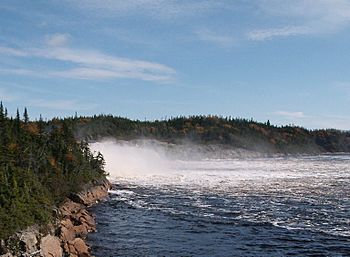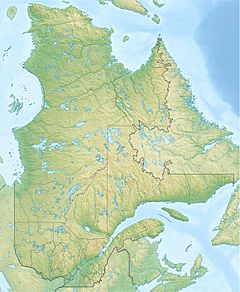Nétagamiou River facts for kids
Quick facts for kids Nétagamiou River |
|
|---|---|

Netagamiou Falls, accessible from the Bob Nunez Misty River Trail
|
|
| Native name | Atauakanaih Hipu |
| Other name(s) | Rivière Nétagamiou |
| Country | Canada |
| Province | Quebec |
| Region | Côte-Nord |
| RCM | Le Golfe-du-Saint-Laurent |
| Physical characteristics | |
| Main source | Little Mecatina River 50°40′23″N 59°36′12″W / 50.673012°N 59.603468°W |
| River mouth | Gulf of Saint Lawrence 50°28′10″N 59°36′26″W / 50.4694444°N 59.6072222°W |
| Length | 23 kilometres (14 mi) |
| Basin features | |
| Basin size | 229 square kilometres (88 sq mi) |
The Nétagamiou River is a beautiful river in the Côte-Nord region of Quebec, Canada. It is also known as the Rivière Nétagamiou in French. This river is famous for its salmon and flows into the big Gulf of Saint Lawrence.
Contents
Where is the Nétagamiou River?
The Nétagamiou River flows through an undeveloped area called Petit-Mécatina. It travels south until it reaches the Gulf of Saint Lawrence. The river's end point is in the town of Côte-Nord-du-Golfe-du-Saint-Laurent. This area is part of the Le Golfe-du-Saint-Laurent Regional County Municipality.
The river's mouth is about 80 kilometres (50 mi) east of La Romaine. This is a special area for the Innu people. It is also only 500 metres (1,600 ft) east of the village of Chevery. Chevery is built on a sandy point and you can reach it by boat from Harrington Harbour.
The entire area that the river drains, called its watershed, is about 229 square kilometres (88 sq mi). The river itself is about 23 kilometres (14 mi) long. It starts from the Petit Mécatina River.
At the mouth of the Nétagamiou River, there is a sandbar. This sandbar creates a narrow channel that is about 1 metre (3 ft 3 in) deep. Behind this sandbar, there is a natural harbor. Boats can travel upstream for about 2 kilometres (1.2 mi). After that, they reach the first waterfalls, which are 15 metres (49 ft) high. You can reach these falls by following a footpath that runs along the first 4 kilometres (2.5 mi) of the river.
What Does the Name Mean?
The name of the Nétagamiou River has changed over many years. In the 1600s, it was spelled Natoüacamiou. Later, in 1740, it was written as Nontagamion. By the 1800s, people spelled it Natagamiou. In the early 1900s, it was sometimes called Nokatamu.
The name might come from the Innu language. One idea is that nétagamiou means "river that goes underground." Another idea is that natuakamiu means "river widens to form a large pool of calm water."
The Innu people have their own name for the river: Atauakanaih Hipu. This name means "lake invaded by water from another lake or river." This shows how important the river is to the local Indigenous communities.
History of the River Area
In the 1700s, Europeans became interested in the Nétagamiou River area. In 1734, a man named Jacques de Lafontaine de Belcour received special permission. He was allowed to trade with Indigenous people and hunt seals for nine years. This area was between the Étamamiou and Nétagamiou rivers.
He set up a trading post near where Chevery is today. This post was used for trading furs and hunting seals. From 1737, François Perrault helped run the trading post. Later, in 1740, François Perrault, his son Jacques, and Charles Levreau took over the post. Today, this old trading post is an important archaeological site.
People hunted seals for their skin, meat, and oil. The oil was used for lamps. Hunters used nets stretched across channels along the coast to catch seals. You can still see holes in the rocks where anchors for these nets were held. The site also has remains of buildings. These include the master's house, employee homes, a store, a warehouse, and places for melting seal oil.
In the early days, thousands of seals were caught each year. The number of seals caught went down over time. However, seal hunting continued in the area until the late 1800s.
Fishing in the Nétagamiou River
The Nétagamiou River is a good place to catch Brook trout (Salvelinus fontinalis). These fish are a type of salmon.
For many years, between 1984 and 2017, there were no reports of Atlantic salmon (Salmo salar) being caught. To help protect salmon, rules were put in place. In 2017, on the Nétagamiou River and several other rivers, all salmon had to be released after being caught. This means fishermen had to let them go back into the water. On some other rivers, only young salmon could be kept. On a few rivers, a limited number of large salmon could be kept. These rules help make sure there are enough salmon for the future.


